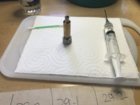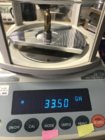You are using an out of date browser. It may not display this or other websites correctly.
You should upgrade or use an alternative browser.
You should upgrade or use an alternative browser.
Sorting bullets, brass, and primers.
- Thread starter Mulligan
- Start date
tom
Gold $$ Contributor
Tom,
Using George's tool the way he showed us, I can sort 6-8 bullets per minute. Is your method faster?
I'm thinking we're doing the same thing, and I'm adding length to it. So theoretically the 3rd measurement would add 33% to the time required. I think.
Tom
Mulligan
Silver $$ Contributor
Has anyone actually tested how seating force effects accuracy? Assuming of course, all the brass was prepared the same way.
If half of your rounds required 12 on your gauge (K&M or Hydro) to seat properly, will those hit the target in a different place than the rounds that required 15 or 18 on the gauge? If so, how much difference on the gauge is required to have it show up on target?
CW
If half of your rounds required 12 on your gauge (K&M or Hydro) to seat properly, will those hit the target in a different place than the rounds that required 15 or 18 on the gauge? If so, how much difference on the gauge is required to have it show up on target?
CW
tom
Gold $$ Contributor
Has anyone actually tested how seating force effects accuracy? Assuming of course, all the brass was prepared the same way.
If half of your rounds required 12 on your gauge (K&M or Hydro) to seat properly, will those hit the target in a different place than the rounds that required 15 or 18 on the gauge? If so, how much difference on the gauge is required to have it show up on target?
CW
Keeping brass on the same cycle, and otherwise good precision practices used, it don't mean a thing until you know what caused it. It matters to me so much, that I take a couple readings on my first few sighters. Once the general range has been noted, I seat too fast to be able to get readings. I do this for seating consistency, as it actually does matter.
Tom
Mulligan
Silver $$ Contributor
Good stuff, thanks Tom!Keeping brass on the same cycle, and otherwise good precision practices used, it don't mean a thing until you know what caused it. It matters to me so much, that I take a couple readings on my first few sighters. Once the general range has been noted, I seat too fast to be able to get readings. I do this for seating consistency, as it actually does matter.
Tom
CW
1/2% total range is pretty tight.
Did you keep track of the 1 thru 20 and do a weight check of dry empty cases?
Distilled water with just a drop of dish soap to reduce surface tension also works and is much closer to 1 g/cm3
Did you keep track of the 1 thru 20 and do a weight check of dry empty cases?
Distilled water with just a drop of dish soap to reduce surface tension also works and is much closer to 1 g/cm3
1/2% total range is pretty tight.
Did you keep track of the 1 thru 20 and do a weight check of dry empty cases?
Distilled water with just a drop of dish soap to reduce surface tension also works and is much closer to 1 g/cm3
I've got a lot of time now so I'm gonna measure all of them than sort them into 50's for my match ammo
I'll keep track of them and see how Labradar numbers look like in relation to case capacity when I get to the range
Has anyone actually tested how seating force effects accuracy? Assuming of course, all the brass was prepared the same way.
If half of your rounds required 12 on your gauge (K&M or Hydro) to seat properly, will those hit the target in a different place than the rounds that required 15 or 18 on the gauge? If so, how much difference on the gauge is required to have it show up on target?
CW
Most recently, a load with my 300 WSM produced two .875" 5-shot groups at 200 yds with light seating pressure (20 psi) while heavier seating pressure gave me an average of .61" (60 psi) over four groups. The load was the same.
Mulligan
Silver $$ Contributor
What do you credit the difference in seating pressure to?Most recently, a load with my 300 WSM produced two .875" 5-shot groups at 200 yds with light seating pressure (20 psi) while heavier seating pressure gave me an average of .61" (60 psi) over four groups. The load was the same.
CW
What do you credit the difference in seating pressure to?
CW
It was on purpose. I established the seating pressure by changing neck tension.
Mulligan
Silver $$ Contributor
There are some powders that want the brass to have a death grip on the bullet.It was on purpose. I established the seating pressure by changing neck tension.
I understand cause and effect....... just do not ask me to explain why.
CW
Mulligan
Silver $$ Contributor
That is crazy close...... amazing really.View attachment 1166622 View attachment 1166621 View attachment 1166623 View attachment 1166624 I’m getting new batch of brass ready for my Dasher 200ea Lapua 6mm BR
2x fired, resized, cleaned with SS pins and trimmed
This morning I was checking internal case capacity using 91% isopropyl alcohol and the results look pretty consistent after 20 cases tested
Nicely done
CW
Now you got me thinking.There are some powders that want the brass to have a death grip on the bullet.
I understand cause and effect....... just do not ask me to explain why.
CW
I've been working on a load for my 6.5 with RL17, 123 scenar's. After OCW test, and seating it printed .27" @ 100, revisiting powder charge yesterday @300 smallest group was .5moa.
Rifle usually shoots in the .3's @300.
Maybe I'll go to the .5moa load and try dropping bushing size and retest.
There are some powders that want the brass to have a death grip on the bullet.
I understand cause and effect....... just do not ask me to explain why.
CW
I think it might have to do with consistency of ignition. Some powder and bullet seating depth combos must need that tiny delay that heavier neck tension theoretically provides. Someone must know for sure.....
Mulligan
Silver $$ Contributor
Why is this important?1/2% total range is pretty tight.
Did you keep track of the 1 thru 20 and do a weight check of dry empty cases?
Distilled water with just a drop of dish soap to reduce surface tension also works and is much closer to 1 g/cm3
CW
Mulligan
Silver $$ Contributor
Tom, what is the black gizzy on the indicator?Clay,
Bullets are pretty simple, group them base to ogive, and then base to seater stem. This, if nothing else, gives consistent seated length to land relationship.
Base to tip is often overlooked, I sort this regardless, as it's about BC consistency. George Macdonald makes a great tool to go with your indicator stand. I love my I gaging 2" travel digital that @dmoran found online a couple years back. I never move my bullet and measure(sort) all 3 things.
View attachment 1166438
View attachment 1166439
I must admit I've given up on Roy's for the two ogive readings. They basically are good enough to check your, and your toolings' limitations lol.a simple check of your seated match rounds will identify any "accidents".
Tom
CW
tom
Gold $$ Contributor
Tom, what is the black gizzy on the indicator?
CW
I think you're referencing the knob for the clamp, witch is part of the stand. I had to look at my own picture, and that's all I see that would be black.
Tom
Mulligan
Silver $$ Contributor
OK, that makes senseI think you're referencing the knob for the clamp, witch is part of the stand. I had to look at my own picture, and that's all I see that would be black.
Tom
thanks
CW
Similar threads
Upgrades & Donations
This Forum's expenses are primarily paid by member contributions. You can upgrade your Forum membership in seconds. Gold and Silver members get unlimited FREE classifieds for one year. Gold members can upload custom avatars.

Click Upgrade Membership Button ABOVE to get Gold or Silver Status.
You can also donate any amount, large or small, with the button below. Include your Forum Name in the PayPal Notes field.
To DONATE by CHECK, or make a recurring donation, CLICK HERE to learn how.

Click Upgrade Membership Button ABOVE to get Gold or Silver Status.
You can also donate any amount, large or small, with the button below. Include your Forum Name in the PayPal Notes field.
To DONATE by CHECK, or make a recurring donation, CLICK HERE to learn how.













